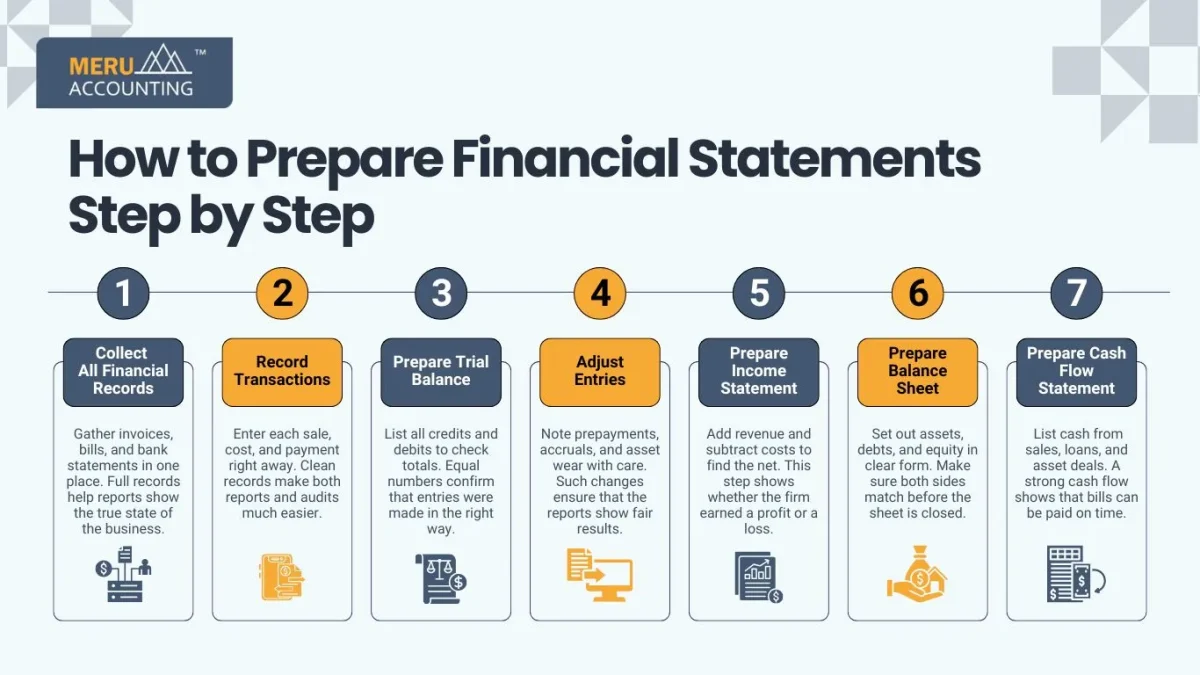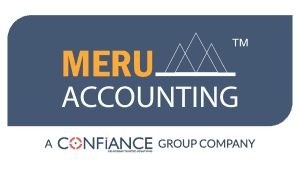Essential Tips for Creating Financial Statements and Cash Flow Insights for Small Businesses
Financial statements are key for every small business owner. They provide useful insights into money earned and money spent. They also help to check if a business is stable. Without these reports, it becomes hard to measure growth or success.
Cash flow is another important part of business health. A company may earn good profits but still lack cash. Poor cash flow makes it tough to pay bills on time. Learning how to prepare financial statements and manage cash flow is vital.
Why Financial Statements Matter for Small Businesses
- Financial statements give a clear view of business health and growth. Owners can use them to spot trends and results.
- These records track income, costs, and profit margins with ease. Money flow stays under control when checked at the right time.
- Banks and investors look at statements before giving funds. A strong report builds trust and makes loan approval simple.
- Progress over the past years is easy to compare with reports. Business gaps can be found early and fixed on time.
- Smart financial choices come from clear and true data. Future plans work better when based on facts, not guesswork.
Key Types of Financial Statements
1. Income Statement
- Shows revenue earned and all expenses recorded clearly.
It highlights whether the company is making a profit or a loss. - Helps to measure net earnings for any time period.
It also shows if the business covers daily costs.
2. Balance Sheet
- List assets, liabilities, and equity for the business.
It provides a snapshot of financial standing at once. - Shows what the business owns and what it owes.
It also highlights the owner’s equity after all debts.
3. Cash Flow Statement
- Records both inflows and outflows of actual money.
This ensures the business has funds for daily needs. - Helps owners see when money problems may arise.
It supports good planning for both the short and long term.
How to Prepare Financial Statements Step by Step
Step 1: Collect All Financial Records
Gather invoices, bills, and bank statements in one place. Full records help reports show the true state of the business.
Step 2: Record Transactions
Enter each sale, cost, and payment right away. Clean records make both reports and audits much easier.
Step 3: Prepare Trial Balance
List all credits and debits to check totals. Equal numbers confirm that entries were made in the right way.

Step 4: Adjust Entries
Note prepayments, accruals, and asset wear with care. Such changes ensure that the reports show fair results.
Step 5: Prepare Income Statement
Add revenue and subtract costs to find the net. This step shows whether the firm earned a profit or a loss.
Step 6: Prepare Balance Sheet
Set out assets, debts, and equity in clear form. Make sure both sides match before the sheet is closed.
Step 7: Prepare Cash Flow Statement
List cash from sales, loans, and asset deals. A strong cash flow shows that bills can be paid on time.
Tips for Accurate Financial Statements
- Always update records daily to avoid missing entries.
Regular updates make reporting simple and stress-free. - Keep personal and business expenses separate always.
Mixing money makes financial statements unclear and confusing. - Reconcile all bank accounts at the end of the month.
This ensures no errors or hidden charges remain. - Review numbers carefully before preparing any report.
This avoids mistakes that may harm decision-making. - Use trusted accounting software for recording data daily.
Technology helps reduce errors and saves business time. - Get expert advice if numbers seem unclear anytime.
Professionals provide clarity and improve overall accuracy.
Why Cash Flow Insights Are Important
- Show if a business can pay bills on time.
This prevents late fees and protects the business’s credit score. - Help owners plan for growth and new investments.
Good insights guide expansion without harming liquidity. - Warn about possible shortages well before they occur.
This allows action before problems get very serious. - Build trust with banks, lenders, and outside investors.
Strong cash flow proves a business can repay loans.
Tips to Improve Cash Flow
- Send all invoices quickly to speed up payments.
Early billing reduces the chances of late or missed payments. - Offer small discounts for early payments from clients.
This improves inflow while keeping customers very happy. - Avoid keeping excess inventory that ties up cash.
Keep only the stock needed for steady business demand. - Negotiate longer payment terms with trusted suppliers.
This creates room to balance inflow and outflow. - Track overdue accounts and remind clients politely.
Consistent follow-ups reduce unpaid dues and cash stress. - Cut all non-essential expenses that hurt cash flow.
Focus only on costs that add business value. - Keep an emergency reserve for slow periods.
Cash savings help handle sudden costs with ease.
Common Mistakes Small Businesses Make
- Not preparing financial statements on a regular basis.
This leaves owners blind to the real financial position. - Ignoring cash flow reports until problems appear later.
Delays often lead to bigger risks and stress. - Mixing personal and business funds into one account.
This creates confusion and wrong financial statements later. - Overestimating sales and underestimating operating expenses.
Wrong assumptions can lead to major financial trouble. - Not reviewing financial data frequently for trends.
Lack of review prevents timely decisions for growth.
Benefits of Using Accounting Software
- Saves time and reduces errors in daily entries.
It also makes reports available instantly for review. - Creates clear financial statements without complex work.
Owners get ready insights at the click of a button. - Tracks real-time cash flow for better planning.
Owners can see shortages before they become big. - Offers detailed reports for decision-making purposes.
This improves accuracy in future strategies and growth. - Easy for business owners with little accounting knowledge.
Software provides user-friendly dashboards and simple tools.
Role of Accountants in Small Businesses
- Accountants prepare clear financial statements for review and filing. Their work keeps the firm in line with laws and rules.
- Cash flow advice is also part of their role. Owners can plan better and avoid money issues ahead.
- They guide on taxes, rules, and other compliance needs. Good advice cuts the risk of fines and builds a strong standing.
- Mistakes that waste both time and cash are avoided with help. Expert support makes daily work smoother for small firms.
- Audits, reports, and investor needs are handled with care. This builds trust and makes it easier to get funds.
How to Read and Understand Financial Statements
- Review the income statement to compare revenues and expenses.
This shows if sales cover operating costs fully. - Study the balance sheet to check assets and liabilities.
It highlights how much the business owns or owes. - Focus on operating cash in the cash flow statement.
It reveals if daily operations bring positive inflows. - Compare reports from one month to the next.
Trends reveal whether the business grows or declines. - Use all insights to plan actions for success.
Data helps reduce risks and guide wise decisions.
Financial Statements and Business Growth
- Show which business areas create the most profit.
This guides owners on where to invest further. - Identify products or services that cost too much.
Owners can cut or adjust based on insights. - Highlight cash flow issues before they grow worse.
This keeps growth plans safe and well-managed. - Support expansion plans with data-backed evidence.
Investors and lenders trust businesses with clear numbers. - Build confidence among staff, partners, and customers.
Strong reports show the business is always healthy.
Practical Steps to Stay Financially Strong
- Keep accounts up to date at least once each week. Fresh records stop backlogs and lower the risk of errors.
- Check cash flow at the close of every month. This step makes sure there is enough money for bills.
- Look at financial statements at least once each quarter. Quick reviews allow early action for better health.
- Plan a yearly budget and follow it with care. A strong budget helps cut waste and build savings.
- Use reports to refine goals and guide growth. Real numbers give owners facts to make smart choices.
Financial statements and cash flow insights are key tools. They guide small businesses in planning and growth wisely. Without them, owners may miss important financial problems early. Strong records also help in building trust with banks.
Knowing how to prepare financial statements gives confidence. Owners gain control over money and reduce business risks. Good cash flow ensures stability even during slow seasons. Clear reports make it easy to manage operations smoothly.
At Meru Accounting, we provide expert help for small firms. We prepare accurate financial statements and detailed cash flow reports. Our services ensure every client stays audit-ready always. We also give smart insights to improve financial planning. Business owners trust Meru Accounting to save time and reduce stress.
FAQs
- Why are financial statements important for small businesses?
They show profits, costs, and growth in clear numbers. Owners can see how the firm is doing at a glance. - How often should I prepare financial statements?
Monthly reports give the best insight into progress. A quarterly check also helps track long-term trends. - What is the main purpose of a cash flow statement?
It shows money coming in and going out over a set time. This helps check if the firm can meet its bills. - Can I prepare financial statements without an accountant?
Yes, it is possible, but expert help or software adds more accuracy. Extra support reduces errors and saves time. - How can I improve my business cash flow?
Send out invoices on time, cut costs when needed, and track late payers. Small steps can build strong cash reserves. - What is the link between financial statements and growth?
Reports point out strong and weak areas in the firm. Owners can act fast and focus on growth goals. - Which financial statement should I prepare first?
Begin with the income statement to check profit or loss. Then prepare the balance sheet and cash flow next.








